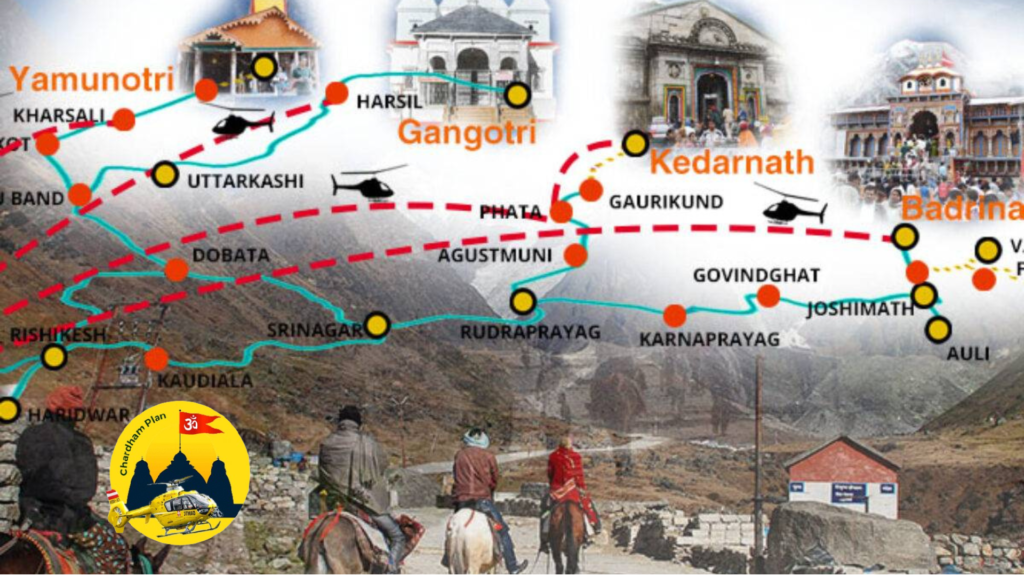
The Chardham Yatra is a sacred pilgrimage that takes devotees to the four holy shrines of Yamunotri, Gangotri, Kedarnath, and Badrinath. Each site is revered for its unique spiritual significance and the divine experience it offers. Proper planning is essential to make this pilgrimage a fulfilling and memorable journey. This comprehensive guide will help you understand the best time to visit, the most efficient routes, and essential travel tips for a successful Chardham Yatra.
Best Time to Visit Chardham Yatra
Optimal Seasons
The Chardham Yatra season typically begins in late April or early May and continues until November, with the peak pilgrimage period being from May to June and September to October. These months offer the most favorable weather conditions, ensuring a safe and comfortable journey.
- Spring (April to June): This is the best time to visit due to mild weather, making it ideal for trekking and sightseeing.
- Autumn (September to November): Post-monsoon season offers clear skies and pleasant temperatures, enhancing the spiritual experience.
Avoiding the Monsoon Season
The monsoon season, from July to August, is generally avoided due to heavy rainfall and the risk of landslides. The treacherous weather conditions can make travel dangerous and hinder the overall pilgrimage experience.
Routes to the Chardham Yatra
Starting Point: Haridwar/Rishikesh
Most pilgrims begin their journey from Haridwar or Rishikesh, both of which are well-connected by road, rail, and air. These cities serve as the gateway to the Himalayas and the starting point for the Chardham circuit.
Route Overview
- Haridwar/Rishikesh to Yamunotri
- Yamunotri to Gangotri
- Gangotri to Kedarnath
- Kedarnath to Badrinath
- Badrinath to Rishikesh/Haridwar
Detailed Route Itinerary
Haridwar/Rishikesh to Yamunotri
- Distance: Approx. 220 km by road to Barkot, followed by a 36 km drive to Janki Chatti and a 6 km trek to Yamunotri.
- Highlights: The trek to Yamunotri offers breathtaking views and includes the Surya Kund hot springs.
Yamunotri to Gangotri
- Distance: Approx. 230 km by road from Yamunotri to Uttarkashi, followed by a 95 km drive to Gangotri.
- Highlights: The scenic drive along the Bhagirathi River and the serene ambiance of the Gangotri Temple.
Gangotri to Kedarnath
- Distance: Approx. 250 km by road to Gaurikund, followed by a 16 km trek to Kedarnath.
- Highlights: The challenging trek through picturesque landscapes to the sacred Kedarnath Temple.
Kedarnath to Badrinath
- Distance: Approx. 230 km by road.
- Highlights: En route, visit Joshimath and experience the spiritual atmosphere of the Badrinath Temple.
Badrinath to Rishikesh/Haridwar
- Distance: Approx. 300 km by road.
- Highlights: The drive back offers an opportunity to reflect on the spiritual journey and enjoy the scenic beauty of the Himalayas.
Essential Travel Tips for Chardham Yatra
Physical Preparation
Preparing physically is crucial for the Chardham Yatra, especially for the treks to Yamunotri and Kedarnath. Regular walking, cardio exercises, and strength training are recommended to build stamina and endurance.
Packing Essentials
- Clothing: Carry warm clothes, rain gear, and comfortable trekking shoes.
- Medical Kit: Include essential medications, altitude sickness tablets, and a first aid kit.
- Personal Items: Pack a water bottle, snacks, toiletries, power bank, and necessary travel documents.
Accommodation Tips
- Advance Booking: Ensure you book your accommodations in advance, especially during peak seasons. Options range from budget hotels to guesthouses and dharamshalas.
- Local Stay: Opt for local accommodations to experience the culture and hospitality of the region.
Altitude Sickness Awareness
Altitude sickness is a common concern during the Chardham Yatra due to the high elevation of the shrines. Symptoms include headaches, nausea, and dizziness. To mitigate the risk:
- Stay Hydrated: Drink plenty of water.
- Acclimatize: Spend an extra day at intermediate stops to acclimatize.
- Medication: Carry prescribed altitude sickness medications.
Respect Local Customs and Environment
- Dress Modestly: Wear respectful clothing, especially in temples and religious sites.
- Follow Rituals: Participate in local customs and rituals with sincerity.
- Environmental Care: Maintain cleanliness, avoid littering, and respect the natural surroundings to preserve the sanctity of the pilgrimage sites.
Emergency Contacts
- Local Authorities: Keep a list of local emergency contacts, including police, medical facilities, and local guides.
- Travel Insurance: Consider purchasing travel insurance that covers medical emergencies, trip cancellations, and other unforeseen events.
Conclusion
The Chardham Yatra is a profound spiritual journey that requires careful planning and preparation. By choosing the best time to visit, understanding the routes, and following essential travel tips, first-time pilgrims can ensure a smooth and enriching pilgrimage. Embrace the divine experience and the breathtaking beauty of the Himalayas as you embark on this sacred journey.
